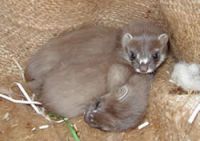Research projects
1. Biodiversity and conservation

Stoats
Genetic diversity varies significantly between populations and regions. Determining the extent and distribution of genetic variation provides information that can be used to direct conservation actions. An example of this in use would be identifying the most genetically diverse and unique populations, which enables conservation priorities to be determined and guide management actions in response. The preservation of genetic diversity in endangered species is important because long-term survival depends on species maintaining sufficient genetic variability to facilitate adaptation to new environmental pressures including habitat modification. Decreasing genetic diversity can result in inbreeding depression, the breakdown of reproductive processes and diminished evolutionary potential – factors ultimately contributing to extinction.
Current research projects:
- Conservation genetics of New Zealand native flora and fauna
- Investigation of non-invasive sampling and monitoring methods
2. Molecular systematics, phylogenetics and genomics
DNA sequence information provides some interesting insights into the evolutionary history (phylogeny) of our native species. New Zealand has had a turbulent geological and climatic history and this has left an imprint on modern biodiversity. The New Zealand flora and fauna is highly endemic and contains many biological oddities and many threatened species. Phylogenetic and genomics studies provide a framework for understanding the origins and patterns of genetic diversity among groups of species and reveal a remarkable history of arrivals, dispersals, adaptations and extinctions.
Current research projects:
- Molecular systematics of New Zealand native invertebrates
- Molecular systematics of New Zealand fungi and bacteria
- Conservation genomics of threatened invertebrates and fungi
- Genomics to understand the genetic basis and evolution of adaptation
- Population genomics to reconstruct population history and demography
- Environmental DNA tools to measure biodiversity
3. Biosecurity and diagnostics
New Zealand has some of the worst cases of environmental damage caused by introduced pests. Biosecurity-related research is focused on preventing further introductions of unwanted organisms and controlling, managing or eradicating them should they arrive in the country. Molecular applications include the use of DNA-based methods to detect and identify new or unwanted organisms, non-invasive techniques for monitoring existing pest populations and developing novel methods to support biosecurity actions.
Current research projects:
- Molecular approaches to monitor and enhance biological control
- Pest monitoring using non-invasive DNA methods
- Wildlife forensics
- Wildlife disease diagnostics and monitoring.
- Pest control technologies
- Plant pathogen diagnostics
4. Vertebrate pest management
Aotearoa is an island ecosystem; this means that most terrestrial conservation now concerns controlling and eradicating the exotic pest species that have arrived with people. Genetic technologies have the potential to inform these control operations, maximising their success and efficiency, leading to better ecological outcomes. We collaborate with DOC, Regional Councils, and other environmental groups on projects where genetic information can inform management.
Current research projects:
- Landscape genetics of Taranaki mustelids
- Calculating the invasion rates of pest animals to Island sanctuaries
- Diet analysis of pests
- Forensic individual ID of pest species
- Pest genomics for species specific toxin development
Key contact

